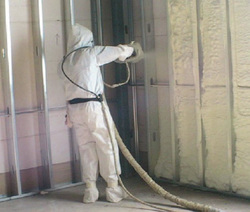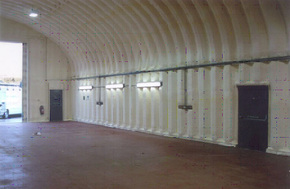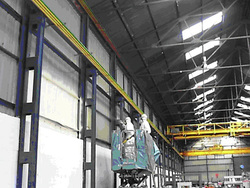Insulation

- Summary about Foam Insulation
- Details for U Values
- Materials Foam Insulation can be used on
For use in medium sized to large scale buildings, the most commonly used form of insulation for filling in voids, and making the buildings more efficient, is foam.
The foam’s main aim is to stop airflow through the building’s facade, resulting in a warmer environment, and also keeping the building cooler in the summer if this is a problem. It also eliminates roof condensation if this is a problem within the building also. Generally any U value can be achieved using the spray insulation, by altering the thickness to suit. The foam has excellent insulation values, offering approximately twice the insulation value of mineral wool. Here are some approximate values:
The foam’s main aim is to stop airflow through the building’s facade, resulting in a warmer environment, and also keeping the building cooler in the summer if this is a problem. It also eliminates roof condensation if this is a problem within the building also. Generally any U value can be achieved using the spray insulation, by altering the thickness to suit. The foam has excellent insulation values, offering approximately twice the insulation value of mineral wool. Here are some approximate values:
There are many companies now which carry out the task professionally offering a service which is efficient, taking little time and causing minimal disruption to the day to day running of the business. A large warehouse could take as little as 1 day to complete, and can still function due to the fact the foams contain no toxic chemicals. The foam is therefore suitable for all environments including, schools and hospitals because it contains harmless substances.
The foam is very flexible allowing most materials to be insulated using this method, and can also be applied in a range of thicknesses, from as little as 25mm depending on the buildings requirements. These are just some of the materials insulating foam can be applied to:
· Steel
· Aluminium
· Asbestos
· Concrete
· Plastic
· Stone
· Brick
· Tile/Slate
Due to this versatility of materials it can be used with it can also be applied to walls, roofs or any area of the building that needs insulating to improve its thermal performance.
Different foams are available dependant on the material it’s being bonded to, all of which will be decided by specialists if required. A wide range of colours are also available providing a clean coloured interior finish if required. Formulas can also be used creating foams which are waterproof, fire resistant or even resistant to ultra violet attack.
The foam is very flexible allowing most materials to be insulated using this method, and can also be applied in a range of thicknesses, from as little as 25mm depending on the buildings requirements. These are just some of the materials insulating foam can be applied to:
· Steel
· Aluminium
· Asbestos
· Concrete
· Plastic
· Stone
· Brick
· Tile/Slate
Due to this versatility of materials it can be used with it can also be applied to walls, roofs or any area of the building that needs insulating to improve its thermal performance.
Different foams are available dependant on the material it’s being bonded to, all of which will be decided by specialists if required. A wide range of colours are also available providing a clean coloured interior finish if required. Formulas can also be used creating foams which are waterproof, fire resistant or even resistant to ultra violet attack.
Summary of advantages of Foam Spray insulation:
· Increases buildings thermal efficiency
· Quick and easy to install
· Relatively cheap
· Minimal disruption and preparation required
· Can be used on a wide range of materials
· Can be used on complex roof and wall shapes
· Provides a complete building seal
· Stops interior condensation
More information on http://www.foam-insulation.co.uk/building-regulations.html
· Increases buildings thermal efficiency
· Quick and easy to install
· Relatively cheap
· Minimal disruption and preparation required
· Can be used on a wide range of materials
· Can be used on complex roof and wall shapes
· Provides a complete building seal
· Stops interior condensation
More information on http://www.foam-insulation.co.uk/building-regulations.html



